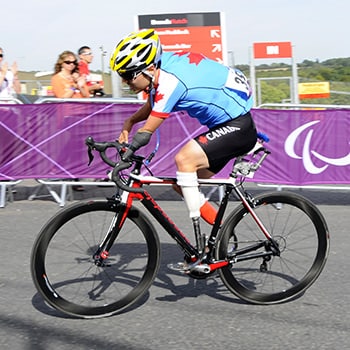Cycling has been part of the Paralympic Games since 1992 although athletes with a disability have been competing in cycling since the early 1980s. Cycling events are open to all athletes with physical and visual disabilities.
In 2007, cycling for riders with a disability was fully integrated into the disciplines governed by the International Cycling Union. Cycling races for handicapped riders are now listed on its calendar, governed by its regulations and verified by its commissaires.
As of 2010, Para-cycling competition at the Paralympic Games includes track and road events for individuals and teams. The track events are individual sprint, team sprint, individual pursuit, and 500m time trial, Road events are massed-start road races, team relay and individual time trials. Events are for both men and women, with the cyclists grouped together according to their functional ability. Some events are open only to specific impairment groups.
In Canadian competition, some Para-cyclists are integrated into able-bodied cycling events, while others compete only with Para-cyclists, depending on the class of impairment and functional ability of the athlete.
Information
-
Long-Term Athlete Development or Para-Cyclists
Cycling Canada’s Long-Term Development guide for Para-Cycling is focused on the particular needs of athletes with a impairment in cycling. It is intended to be used alongside the Cycling Canada Cyclisme LTAD Guide, as well as the LTAD publication No Accidental Champions. It is a guide for coaches, athletes, parents and sport leaders to welcoming Para-cyclists to the sport and to providing LTAD-based programs from entry to Active for Life stages.
-
Rules
Cycling is governed by the rules and regulations of the UCI (Union Cycliste Internationale) together with the following rule modifications:
- Amateur riders may race as pilots, provided they have not been selected by their national federation for any of the UCI-listed events in the previous three calendar years.
- No professional riders may compete as a pilot.
- An ex-professional rider must not have held a professional license for three calendar years and must not be earning all or part of his/her living from cycle racing for a period of three calendar years.
-
Categories
Competitors are classified into 4 broad categories with separate events for each:
- B1-B3: Blind and visually impaired athletes who use a Tandem;
- C1-C5: Cycle, including some amputee and Cerebral Palsy and/or Traumatic Brain-Injured athletes, who use a regular bike;
- T1-T2: Tricycle, including some Cerebral Palsy and/or Traumatic Brain-Injured athletes;
- H1-H4: Handcycle, including some neurologically-impaired, spinal-cored Injured, and Amputee athletes who use a handcycle rather than a regular bicycle.

